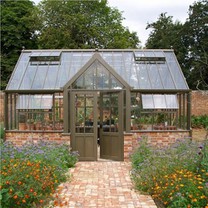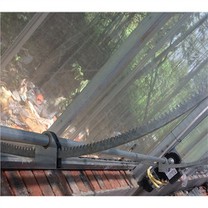The Netherlands is located in a high latitude area, which is affected by the ocean. It is warm in winter and cool in summer. However, the annual sunshine time is very small (about 1500h). In order to maximize the light transmittance of the greenhouse, this kind of all-glass greenhouse has appeared. In the later stage, it gradually developed into a diffuse scattering glass at the top, which allows light to pass through the glass evenly to reduce burns to plants. The skeleton adopts the white spray plastic greenhouse skeleton to reduce the shadow in the greenhouse. The earliest VENLO glass greenhouse has a span of 6.4m-12m, a bay of 4m, and a height of 4-6m. Each span is composed of two spires, which are later optimized and gradually become the main structure column truss support. The roof is composed of special aluminum alloy profiles, which greatly improves the light transmittance and the degree of mechanization. Therefore, this kind of all-glass greenhouse abroad is just this The town is named VENLO glass greenhouse. With the wide application of Wenluo glass greenhouse, some greenhouse technologies have been developed and applied one after another, and the yield of crops is getting higher and higher. Slowly, some new varieties that are resistant to diseases, high-yield, and suitable for seasonal cultivation are slowly developed, and the Netherlands has gradually become a major agricultural country.
After the 1970s, soilless cultivation slowly became popular, and the application of rock wool cultivation greatly improved the level of cultivation control, making mechanization and automation a reality. In the early 1980s, the Internet of Things system for the top ventilation system of the insulation system has been rapidly developed, forming a factory model integrating planting, seedlings, harvesting and packaging. Tomato production has increased by 5 times.
However, with the rapid development of greenhouses, the problem of irregular structures has also occurred. The collapse of the greenhouse occurred in rainy, snowy and windy weather, which caused heavy losses to farmers and insurance companies. In 1978, the first greenhouse structure standard came out, from civil construction to structural construction. The installation has clear requirements. By the 1990s, the scale of greenhouse development in the Netherlands was basically not expanding, but paying more attention to the cultivation of greenhouse research and development seedlings, making greenhouse technology more mature and allowing greenhouses to develop in the direction of intensification and scale. In order to increase land utilization, the Dutch government avoided the need for large amounts of sunlight and low-priced crops to vigorously develop horticulture, animal husbandry and processing industries, and used agricultural subsidies to increase farmers' income. The experience of the Dutch model is worth learning from.
In the 21st century, China began to introduce the Dutch model, but unlike the Dutch Venlo glass greenhouse, China has sufficient sunlight and the temperature is hot in summer. In order to prevent the temperature inside the greenhouse from being too high, the Chinese glass greenhouse has added an external shading system, and now the top of the domestic glass greenhouse is common The 8mm solar panel is used, which is light in weight and has a long service life, which is more heat-preserving and safer than glass. Although domestic multi-span glass greenhouses have developed rapidly in recent years, compared with the Dutch model, Chinese agriculture still has a long way to go.






